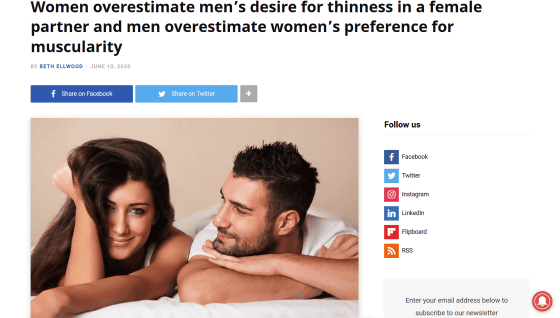Women are overly convinced that 'thinners are more popular' and men are 'macho is more popular'

The desire to be attractive to the opposite sex is a great motivation for people who are on a diet or strength training in search of their ideal body shape. However, a new study investigating the 'ideal body shape for the opposite sex' that men and women think of, found that the 'ideal body shape for the opposite sex' that men and women think is different from the body shape that the opposite sex actually wants. ..
Misperceptions of opposite-sex preferences for thinness and muscularity --Lei ---- British Journal of Psychology --Wiley Online Library
Women overestimate men's desire for thinness in a female partner and men overestimate women's preference for muscularity
https://www.psypost.org/2020/06/women-overestimate-mens-desire-for-thinness-in-a-female-partner-and-men-overestimate-womens-preference-for-muscularity-57006

By Western aesthetic standards, women generally tend to think that 'thinners are more attractive to the opposite sex' and men tend to think that 'muscular machos are more popular'. Therefore, people who have a sense of crisis that 'my body shape is not attractive to the opposite sex' work hard on diet and muscle training to do body makeup, but sometimes diet and muscle training go too far and hinder health. There are also cases. For example, a 2004 study found that women who are more likely to think that men prefer leaner women are more likely to have an eating disorder due to excessive dieting.
So, researchers at the University of St Andrews , Xue Lei and David Perrett, told the heterosexual European men and women between the ages of 17 and 26 in the UK, 'I think of my ideal body shape. I conducted an experiment to find out 'a body shape that seems to be ideal for the opposite sex.'

The research team uses body shape data of men and women acquired from the smartphone app 'BMI 3D PRO', and in the case of men, the body mass index (BMI) is 18 to 30 in 13 stages, and the body fat percentage is 12% to 22%. Create models of various body shapes in the range of 11 stages. In the case of women, BMI was 16 to 28 in 13 stages, and body fat percentage was 22% to 32% in 11 stages, and models of various body shapes were created in the same way.
Using this model, the subject is asked to 'own body shape', 'ideal body shape for me', 'body shape that the opposite sex would think is ideal as a' partner with a short-term relationship '', and 'the opposite sex is a' long-term relationship '. A body shape that you would think is ideal as a 'partner who connects sex' 'a body shape of the opposite sex that is ideal as a' partner that connects short-term relationships '' 'A body shape that is ideal as a partner that connects long-term relationships' I was asked to answer about 'body shape'. The subjects were able to change their BMI and body fat percentage by operating the mouse, and answered their own body shapes.
Based on this result, the research team analyzed 'male or female's favorite body shape of the opposite sex' and 'actually the opposite sex's favorite body shape of the opposite sex'. As a result, it was found that the 'attractive female BMI' that men think is larger than the female's actual ideal BMI, and the 'attractive female's body fat percentage' is higher than the female's ideal body fat percentage. .. In addition, it was found that the 'attractive male BMI' that women think is significantly smaller than the ideal BMI for men.
In conducting this experiment, researchers also said, 'Preferences for body types of the opposite sex may change depending on the relationship, and' partners who have short-term relationships 'and' partners who have long-term relationships. ' ], I think they have different body shape preferences. ' As the researchers thought, both men and women of the subjects thought that the 'ideal body shape' required by the opposite sex would be more severe in the 'short-term relationship' than in the 'long-term relationship'. .. However, it seems that the body shape that men and women actually want for the opposite sex did not depend on the duration of the relationship.

In addition, this study also analyzed the difference between the subject's own body shape and the subject's 'ideal body shape.' Then, it was also found that the more the subject's 'body shape that would be preferred by the opposite sex' is far from the actual one, the more likely the subject is dissatisfied with his or her own body shape. In this regard, the researchers said, 'Correcting misunderstandings about heterosexual preferences may help treat or prevent eating disorders or physical dissatisfaction in young men and women.'
Related Posts:
in Note, Posted by log1h_ik







